MORE POSTINGS
WEEK 1: THE SOVIET PLAN TO DESTROY GUANTANAMO (Posted June 4, 2008)
WEEK 2: MISSING OVER THE SOVIET UNION (Posted June 11, 2008)
WEEK 4: THE SHOOTDOWN OF MAJOR ANDERSON (Posted June 25, 2008)
WEEK 5: THE "EYEBALL TO EYEBALL" MYTH (Posted July 2, 2008)
ABOUT THIS SERIES
When Washington Post reporter Michael Dobbs first decided to write a book about the Cuban missile crisis, the question he was most frequently asked was, “What is there new to say about a subject that has been so exhaustively studied?” The answer, it turned out, was “a great deal.” Two years of research in half a dozen countries, including the United States, Russia, and Cuba, turned up a surprising amount of new information about the thirteen days in October 1962 when the world had its closest brush with nuclear destruction. His minute-by-minute narrative also explodes some long-accepted myths, repeated for decades by missile crisis scholars.
Over the next five weeks, the National Security Archive will publish some of the key primary sources behind One Minute to Midnight: Kennedy, Khrushchev and Castro on the Brink of Nuclear War. The new information includes such episodes as a startling Soviet plan to destroy the Guantanamo naval base, the storage and handling of Soviet nuclear weapons on Cuba, and the “Eyeball to Eyeball” confrontation between U.S. and Soviet ships that never happened.
The revelations in One Minute to Midnight shed new light on presidential decision-making at moments of supreme tension. Some of the information that flowed into the Oval Office during the crisis was erroneous. U.S. intelligence analysts seriously under-estimated the number of Soviet military personnel in Cuba and failed to identify the bunkers for Soviet nuclear warheads, despite possessing photographic evidence that is being published for the first time in One Minute to Midnight. Soviet and U.S. leaders consistently misinterpreted each other’s signals.
American scholars have traditionally treated the Cuban missile crisis as a case study in the art of crisis management. The historian Arthur Schlesinger, Jr. praised Kennedy’s “brilliantly controlled…matchlessly calibrated” handling of the Soviets. The new revelations suggest that the crisis is better understood as an example of the limits of crisis management and presidential power. As told by Dobbs, the missile crisis is a case study of “government by exhaustion” in which frazzled policy-makers struggle to master the chaotic forces of history that they themselves helped to unleash. |

The Cuban Missile Crisis, 1962
The 40th Anniversary
Docments, photos, audio clips and more from the historic 40th anniversary conference in Havana
|
THIS WEEK: TRACING THE NUCLEAR WARHEADS
Washington, DC, June 18, 2008 - The CIA failed to identify the storage bunkers for Soviet nuclear warheads in Cuba during the October 1962 Cuban missile crisis, despite obtaining numerous photographs of the sites, according to new materials -- including a selection of photos -- being published on the Web today by the National Security Archive.
The precise location of the Soviet nuclear storage bunkers at Bejucal and Managua is revealed for the first time in a new book by Washington Post reporter Michael Dobbs based on interviews with Soviet veterans and raw U.S. intelligence film obtained from the National Archives. Declassified CIA documents show that U.S. intelligence analysts at the time concluded that the sites could not be used for the storage of nuclear weapons because of the lack of visible security measures such as guard posts and extra fencing.
This is the third of five postings looking at the new material in One Minute to Midnight: Kennedy, Khrushchev, and Castro on the Brink of Nuclear War, which draws on the National Security Archive's long-standing documentary work on the Cuban missile crisis. As part of this posting, Dobbs also tracks the dispersal of nuclear warheads from the Bejucal bunker to other sites in Cuba on the night of October 26-27, 1962, at the height of the crisis.
One of the biggest remaining mysteries of the Cuban missile crisis has now been solved. After learning about the existence of medium-range Soviet missiles targeted on the United States on October 16, 1962, President Kennedy repeatedly pressed the CIA for information on the warheads in order to be able to gauge the scope of the threat. The intelligence community made numerous attempts to locate the warheads, but was unable to do so.
While the CIA suspected that the Soviets had brought nuclear warheads to Cuba, it lacked conclusive evidence until after the missile crisis was over. In January 1963, the CIA succeeded in tying a Swedish-built Soviet freighter, the Aleksandrovsk, to the transportation of nuclear weapons to Cuba. Analysts showed that the Aleksandrovsk had sailed to Cuba from a nuclear storage depot near the Soviet Navy port at Severomorsk (near Murmansk) with specially configured vans on deck used for the transportation of nuclear warheads. The subsequent reconstruction of the movements of the Aleksandrovsk is available here.
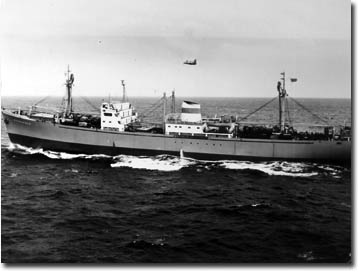 |
The Alapyevsk, sister ship of the Aleksandrovsk |
The Aleksandrovsk was meant to dock in Mariel, Cuba, but it was diverted to the port of La Isabela on the morning of October 23 after President Kennedy declared a naval blockade around Cuba. Its cargo included 24 1-megaton warheads for the intermediate range R-14 missile and 44 14-kiloton warheads for the FKR cruise missile. The R-14 warheads remained on board the ship, while the FKR warheads were sent to Oriente province for targeting on Guantanamo.
Another Soviet ship, the Indigirka, had previously arrived in Mariel on October 4. Its cargo included 36 1-megaton warheads for the medium-range R-12 missile, 36 14-kiloton warheads for FKR missiles, twelve 2-kiloton warheads for Luna/FROG tactical missiles, and six 12-kiloton atomic bombs for IL-28 bombers.
View Larger Map
Details of the movement of all the warheads are provided in One Minute to Midnight. The R-12 warheads offloaded from the Indigirka were taken to the nuclear storage center near Bejucal, according to Soviet veterans interviewed by Dobbs. The Soviets had built an underground ammunition storage facility at Bejucal in late 1961, according to this declassified CIA memo. When the crisis broke, the CIA suspected that the Bejucal site could be used as a storage place for nuclear weapons, and informed President Kennedy on October 16 that it was the "best candidate" for such a site, and marked it for "future surveillance."
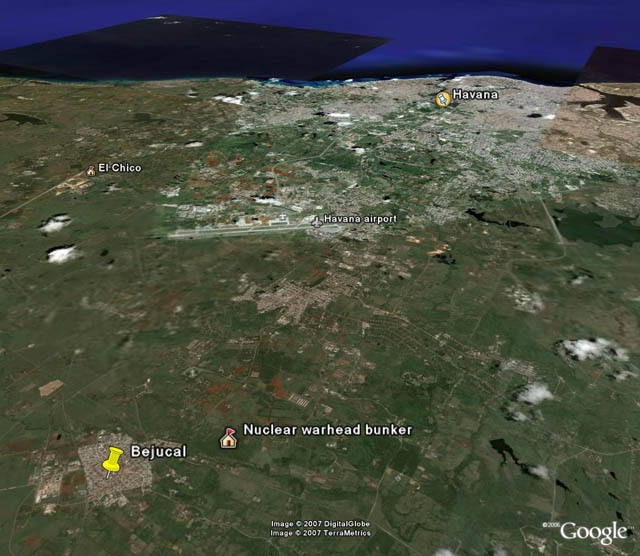
The lack of significant security at the Bejucal site—it was protected by only one fence—caused CIA analysts to revise their assessment. By October 22, however, the CIA had switched its attention to another site closer to Mariel that was surrounded by "double security fences" and numerous "guard tents." U.S. reconnaissance planes continued to fly over Bejucal during the decisive week of October 22-28, but the analysts paid little attention to it because of the lack of visible security.
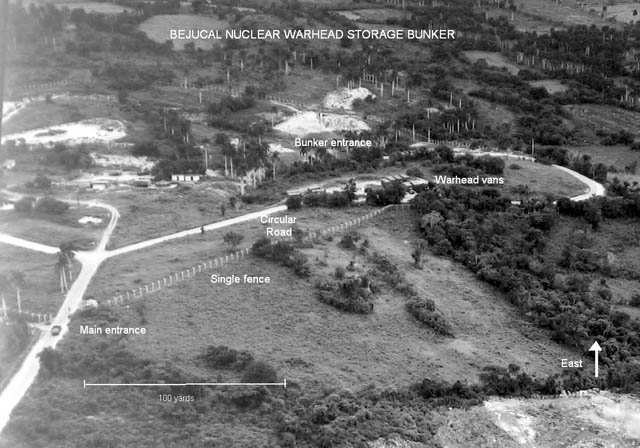
A detailed re-examination of the raw intelligence photographs, combined with interviews with Soviet officers handling the warheads, proves that Bejucal was the central nuclear warhead storage depot. The single security fence, circular road, and remains of the bunker facility are visible in Google Earth, and on Satellite view (click SAT) on the Google Map version above. Key to the identification of Bejucal is the presence of nuclear storage vans, similar to those transported to Cuba on board the Aleksandrovsk. The vans were photographed by low-level U.S. reconnaissance missions on October 23, October 25, and October 26. Click on each date for the relevant photo interpretation report.
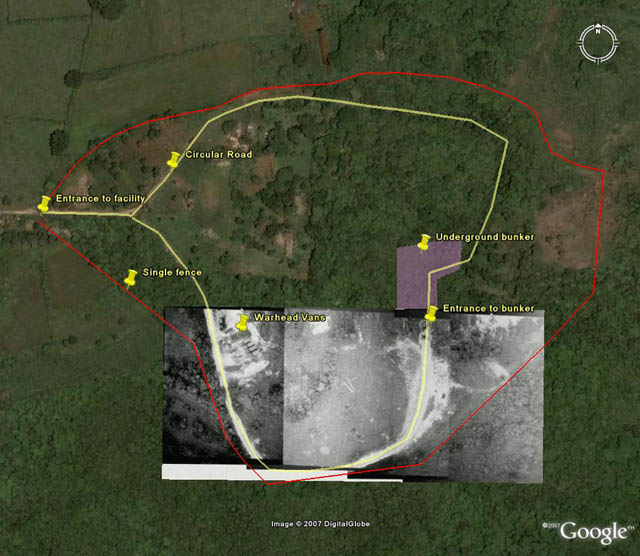
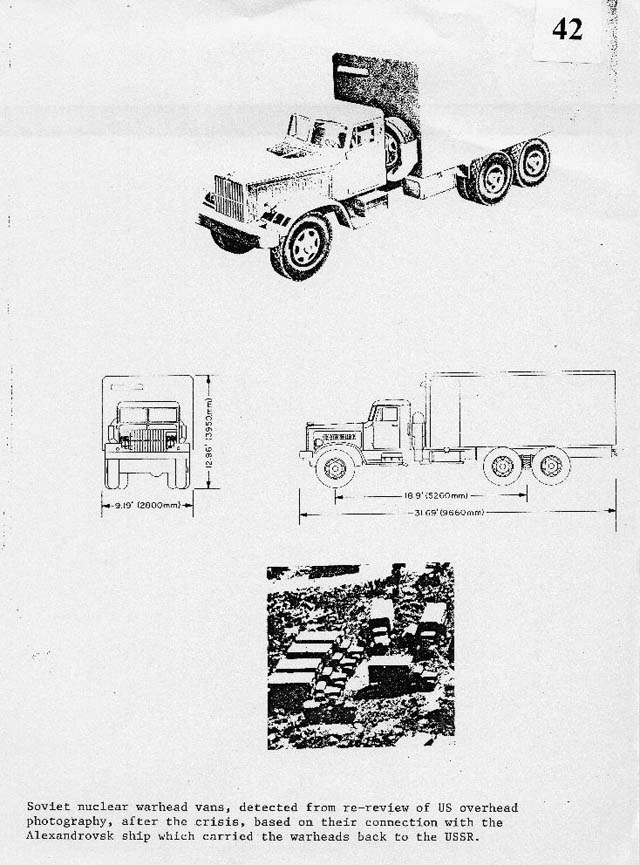
|
The San Cristobal MRBM Site Nr 1 in 1962 (top) and in 1992 (bottom) |
The Soviets were building bomb-resistant nuclear storage facilities at all the missile sites, but these structures were still incomplete by the end of October. Participants in the 2002 Havana conference on the missile crisis, organized by the National Security Archive, were invited to tour one such structure at the San Cristobal MRBM Site Nr 1, which can be seen here alongside a photograph of the same bunker taken during the missile crisis.
On the afternoon of October 26, the Soviet commander on Cuba, General Issa Pliyev, decided to send a consignment of warheads from Bejucal to the R-12 missile sites around Sagua La Grande. The live warheads arrived there around noon on October 27, ready for targeting on Washington and New York, according to Soviet veterans interviewed by Dobbs.
The warheads for the tactical Luna/FROG missiles were stored at another underground facility, near Managua, five miles to the northeast of Bejucal. U.S. intelligence planes also took photographs of this site, but the lack of obvious security measures again confused the analysts.
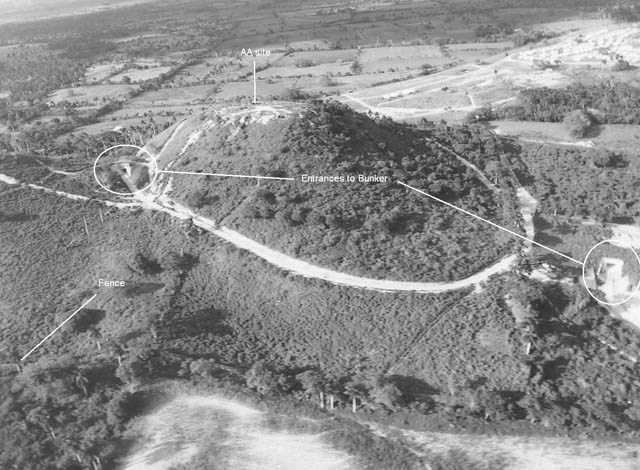
As soon as the missile crisis was over, Khrushchev ordered both the Aleksandrovsk and the Indigirka to return to the Soviet Union with the warheads. The Aleksandrovsk was challenged by a U.S. warship, causing the Kremlin to file a strong protest with Washington, as recorded in a November 10 CIA memo. The U.S. apologized for the incident, without suspecting that the nuclear arsenal was on board the Soviet vessel.
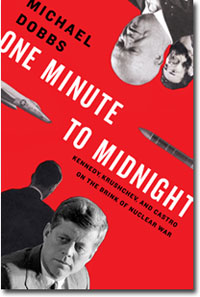 More information on the nuclear storage sites, including the atomic bombs stored in a seaside property previously used by Fulgencio Batista, is available in One Minute to Midnight, available through Amazon.com. More information on the nuclear storage sites, including the atomic bombs stored in a seaside property previously used by Fulgencio Batista, is available in One Minute to Midnight, available through Amazon.com.
If you have Google Earth installed on your computer, you can find the precise locations of the Soviet nuclear warhead sites on Cuba, which are still visible, by downloading this Google Earth file and opening it in the free Google Earth application.
 Open the 'Soviet_warheads' KMZ file in Google Earth Open the 'Soviet_warheads' KMZ file in Google Earth
If you do not currently have Google Earth installed on your computer, you can access this information by taking the following steps:
1. Download and install the free Google Earth application.
2. Download the Google Earth file on Soviet nuclear warhead sites in Cuba and open the file using the Google Earth application.
MORE POSTINGS
WEEK 1: THE SOVIET PLAN TO DESTROY GUANTANAMO (Posted June 4, 2008)
WEEK 2: MISSING OVER THE SOVIET UNION (Posted June 11, 2008)
WEEK 4: THE SHOOTDOWN OF MAJOR ANDERSON (Posted June 25, 2008)
WEEK 5: THE "EYEBALL TO EYEBALL" MYTH (Posted July 2, 2008)
|

